An (un)Holy Trinity of Custom Culture: Von Dutch, Ed Roth and Indian Larry- Part 2
Several accounts exist regarding the origins of the character: one claims he drew it on a bar napkin to illustrate what Mickey Mouse’s dad looked like -he apparently held the Disney rodent in some contempt- another claims he first painted it on a shop refrigerator at Roth Studios after discovering some bad fish inside (although nobody from the studio’s early days remembers it). In his 1980 autobiography Confessions of a Rat Fink: The Life and Times of Ed “Big Daddy” Roth, he holds to the napkin story and dates it in about 1960. It’s possible that Robert Williams or Ed Newton came up with it; but regardless it quickly became an icon of hot rod culture, first appearing in print in a July ’63 issue of Car Craft Magazine. The repulsive little character had personal significance to Roth.
“Whenever I looked at that drawing,I felt I was looking, for the first time, at reality—my reality. The world that my parents, teachers, and responsible type people all around me belonged to wasn’t my world. Why did I have to be like them, live like them? I didn’t. And Rat Fink helped me realize that.”
Up to this point Roth was focusing mainly on paint, and doing little more than “tinkering” with the actual car designs and mechanics. In early 1959 he left Crazy Painters and started Roth Studios in his own garage at 4616 Slausen in Maywood. He had apparently been tossing the idea of building a hot rod from fiberglass around since his army days, and he pulled in Ed Fuller to help him build the first Outlaw. The design was inspired largely by Norm Grabowski’s Kookie Kar, and the fiberglass idea wasn’t exactly new (Corvettes were already in production and Fuller already had experience working with it), but the funky show car did exactly what Roth intended it to do: it attracted the right attention to his booth at the shows and took the magazine covers by storm. By some accounts he actually started the build in 1956, but he first unveiled the machine as Excaliber (sic) in 1959 and it was still more or less a work in progress: it didn’t take the Outlaw moniker until after a few upholstery and wheel changes. But in the words of Pat Ganahl: ” …the Kookie Kar (Grabowski’s T-bucket) was wild, but it was still a conventional hot rod. About the only thing conventional on the Outlaw was the engine and drive line. The coil spring front suspension, four-bar radius rods, jet-age nose, quad headlights, fiberglass body and paint scheme were all extraordinary for a hot rod in 1959 or 1960″.
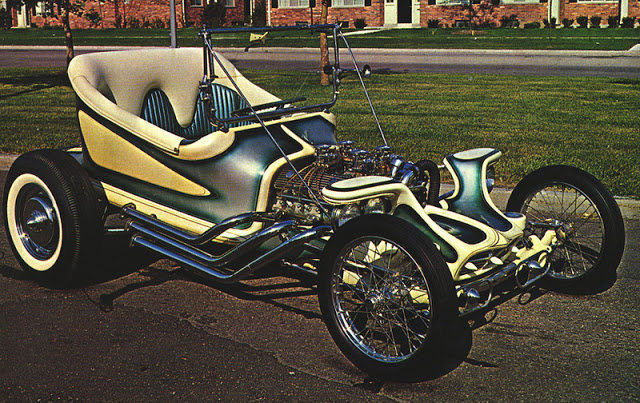 |
| “The Outlaw”, photo from early ’60s |
The Outlaw, however unconventional, was actually street legal and could be driven (although it seldom was). And by promotional standards it was pure gold: Revell picked up on the Outlaw in 1960 and went into production with a 1/25 scale plastic model kit. It was the start of a long and lucrative relationship between Roth and the toy companies, and it was Henry Blankfort -Vice President of Public Relations at Revell- who gave him the name “Big Daddy”.
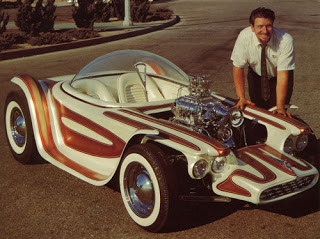 |
| Beatnik Bandit, 1960 |

Until that point though, Roth was pretty much making his living off the catalog sales and magazine ads for stuff like Weirdo T shirts, pin striping kits and custom parts; as mentioned previously, most people agree that the cars were basically promotional tools for that business. His next machine, the Beatnik Bandit, which came out in 1960 was almost purely that. With no pedals or steering wheel and a bizarre single joystick, the car relied on cabled remote control to start, rev, and open or close a bubble canopy that could only fit over a midget. But drivable or not, it was another big hit.
 |
| “Mysterion”, 1963 |
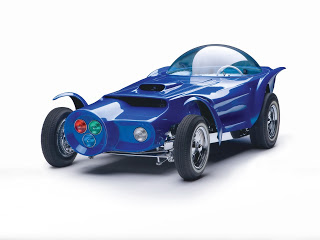 |
| “Orbitron”, 1964 |
In 1964 Roth released the Mysterion, his first multi engine machine. It was followed in ’64 by the Orbitron which featured a dash mounted TV, rotating primary colored lights on the nose and another bubble canopy, this one large enough to be functional. But the Orbitron had a covered engine and subsequently turned out as a disappointment to the crowds who came to gawk at big chrome coated power plants. Revell -his main supporter- took a pass on it. In his words “…When the Beatles appeared on the Ed Sullivan show all the model sales stopped. Kids were buying guitars instead of model cars”.
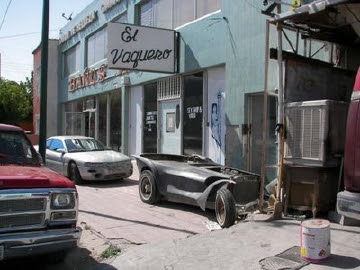 |
| The Orbitron outside a Juarez sex shop in 2007 |
Ed sold the Orbitron in ’67 for $750, and unlike his other machines it faded into obscurity: it passed through a few hands and apparently spent the early ’70s in El Paso, Texas with a For Sale sign stuck on the bubble. After that it basically disappeared until 2007 when Michael Lightbourn rediscovered it rotting away (sans nose cone) in front of a sex shop in Juarez, Mexico. After a year of restoration the car was again released in October 2008.
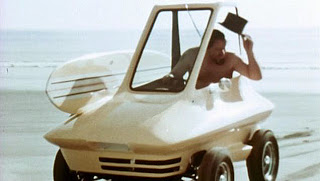 |
| “Surfite” 1964 |
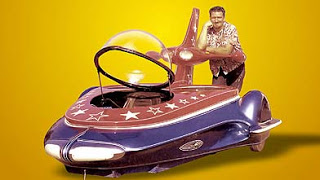 |
| “Rotar” ’65 |
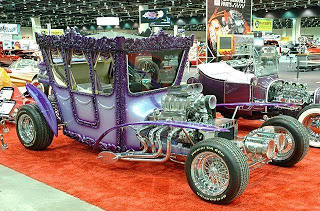 |
| “Druid Princess” ’66 |
 |
| “Road Agent” ’65 |
 |
| “Tweedie Pie” |
During this time Ed also owned and modified Tweedie Pie, a 1920 T-bucket built by Bob Johnston. Roth bought the car ‘in a basket’ and rebuilt it in 1962, adding a Corvette V-8 with six Stromberg 97 carburetors; a rolled and pleated Naugahyde interior, his signature nerf bars and chrome undercarriage along with his own particular brand of pin striping. He sold it around ’65, possibly to raise cash for the other builds.
According to Schreiber:
“By the time I paid for the chassis, bought the rear end, axles, brakes, rear & front wheels and tires, a 392 block, fire suit and helmet, the $5000.00 was gone. After a show Ed had a small tool/nut & bolt room, about 6′ x 6′ with a short ceiling on it and he would throw his loose change on top of it every day. That night, the ceiling came down! I told him, “Man, there must be $5,000.00 worth of change there! Why don’t you sponsor the dragster; we can put your name on it, that way I’ll get paid some extra money and I can pay you back.” He said, “That’s a great idea”.
Ed took almost a 20 year hiatus from his “conventional” (a term difficult to apply to his work) cars and turned his focus to trikes, but in the late ’80s he started L.A. Zoom as something of a comeback attempt. It was never completed: he was trying to mold carbon fiber and using a Honda four cylinder with electronic fuel injection, and by most accounts the technology simply defeated him. Not to be defeated he built Beatnik Bandit II, which again never ran because of electrical difficulties. Revell did a model from it but it received little magazine coverage. His last car was Stealth 2000 in 1999, a Chevy Geo powered roadster that like the Orbitron quickly vanished into oblivion: Nobody seems to know much about it or where it went.
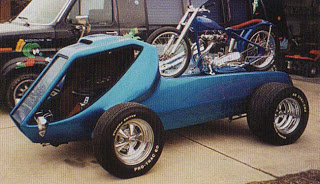 |
| “Mega Cycle” ’68 |
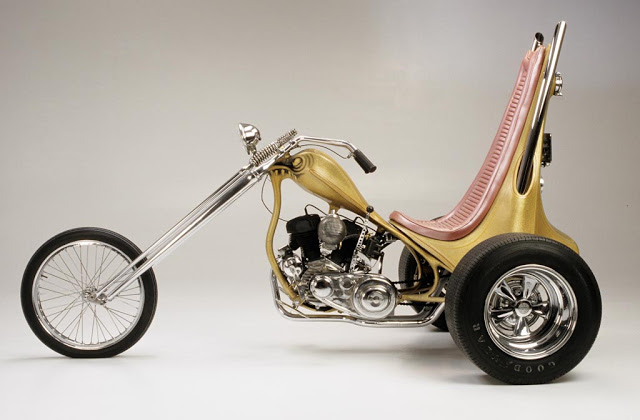 |
| “Candy Wagon” |
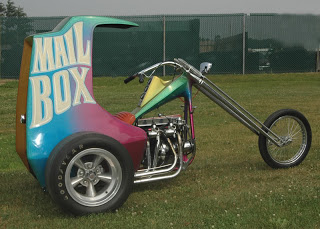 |
| “Mail Box” ’67 |
His first acclaimed show trike was Candy Wagon, with an extended springer and a stock 45 cubic inch Harley flathead. This was followed by the California Cruiser in ’66, a somewhat ungainly machine with an Olds V8 and fat drag tires. He went into production with a kit and by some accounts they were ridiculously fast, clocking up to 140 mph. In ’67 he came out with Mail Box powered by a Crosley four cylinder engine.
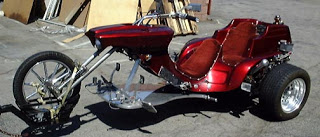 |
| “American Beetle” ’68 |
Around ’68 he started a series of VW powered trikes, including American Beetle (’68); Secret Weapon (’73); Great Speckled Bird (’76) and Globe Hopper (’87) -a three wheeled pseudo coupe that blurred the lines between the cars and trikes.
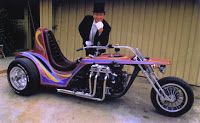 |
| “Asphalt Angel” ’85 |
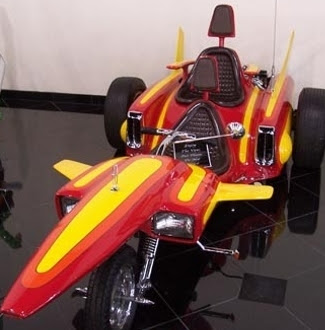 |
| “Great Speckled Bird” ’76 |
 |
| “Globehopper” ’87 |
 |
| “Rubber Ducky” |
Roth died at age 69 on April 4, 2001, reportedly from a heart attack in his workshop at his Utah home.
Ed “Big Daddy” Roth: His Life, Times, Cars and Art: Pat Ganahl, 2003: Car Tech Books


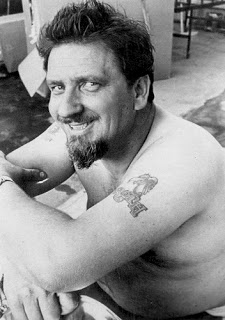
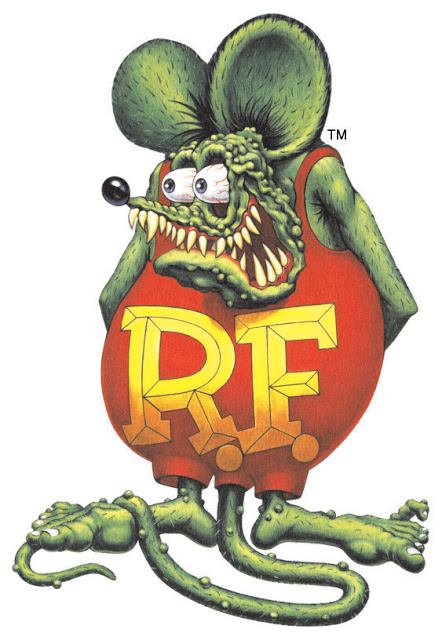



Comments
An (un)Holy Trinity of Custom Culture: Von Dutch, Ed Roth and Indian Larry- Part 2 — No Comments
HTML tags allowed in your comment: <a href="" title=""> <abbr title=""> <acronym title=""> <b> <blockquote cite=""> <cite> <code> <del datetime=""> <em> <i> <q cite=""> <s> <strike> <strong>